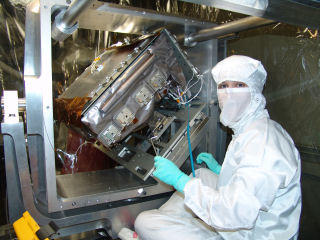Summary
Satellite and rocket instruments for solar ultraviolet and extreme-ultraviolet observation are calibrated using synchrotron radiation at SURF III.
Description

The Extreme-Ultraviolet Variability Experiment package in the course of a SURF III calibration run. Here it is being loaded into a large vacuum chamber on beamline 2.
Space-weather events are naturally occurring phenomena caused by activity on the Sun that affect us here on Earth. Solar storms can impact technology we rely on daily, like e.g. the Global Positioning System (GPS), communication satellites, and electric power grids. Various phenomena that originate from the Sun can result in Space Weather storms. Outbursts from explosions on the Sun - Solar Flares and Coronal Mass Ejections (CME) - send Space Weather storms outward through our solar system. In addition variations in the solar wind streaming from the Sun can have an impact on Earth.
Over the last several years much attention has been paid to space weather in the U.S.: The National Space Weather Strategy and the National Space Weather Action Plan were released in 2015, Executive Order 13744 in 2016, an updated National Space Weather Strategy and Action Plan and Executive Order 13865 in 2019, and finally the PROSWIFT Act was passed into law in 2020.
Early warning of solar storms is partly based on x-ray and ultraviolet sensors monitoring the solar output at short wavelengths. While the total solar irradiance is stable within 0.1 %, the solar spectral irradiance in the short wavelength range can vary by more than 100 % within seconds, thus making the detection of solar events easy.
Historically, solar-observing instruments were calibrated either based on the calculability of synchrotron radiation using the Spectrometer Calibration Beamline at SURF III or using beamline X24C at the National Synchrotron Light Source, which was operated by the Naval Research Laboratory. Recently, beamline X24C was moved to SURF III, so now all U.S. Government assets used in the calibration of x-ray and ultraviolet solar-observing instruments are located at NIST.

